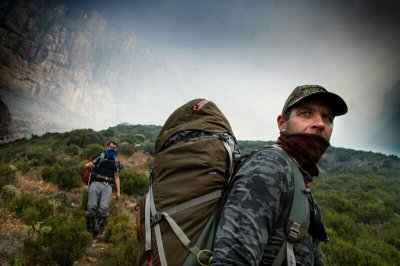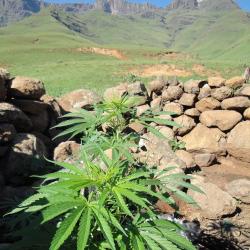BaSotho migrationary patterns
05 May 2022 15:36 #77641
by BergAttie
BaSotho migrationary patterns was created by BergAttie
Last weekend I noticed the absence of any Basotho herders in the Northern Berg. It was clear from the state and smell of the huts that the kraals were only very recently vacated. That got me wondering: What drives the movements of the herdsmen between the Escarpment and Inland areas? I would assume that grazing is better in lower inland plains during winter months. But if that is so why visit the Escarpment areas during summer at all? Or does the Escarpment grazing recover faster in Spring and early summer due to higher rainfall?
Please Log in or Create an account to join the conversation.
05 May 2022 16:26 #77642
by tiska
Replied by tiska on topic BaSotho migrationary patterns
I expect extreme low temperatures are key to these patterns. Herders have lost their lives in snowfalls and the animals likely die too. Dropping below the snowline will help them survive.
Please Log in or Create an account to join the conversation.
05 May 2022 19:30 - 05 May 2022 19:37 #77643
by andrehayward
Replied by andrehayward on topic BaSotho migrationary patterns
Info from a Doctorate Thesis on herders in Lesotho
In order to accommodate the weather changes, in summer, the cattle posts are moved further
high up on the mountain tops where the grazing lands are fertile. In winter, the herders move
down to where the animals can be more easily accessed in times of heavy snowfalls. (1.4.2 pg 31 of 354 & 2.1.2 pg 61 of 354)
ukzn-dspace.ukzn.ac.za/bitstream/handle/10413/13461/Pitikoe_Selloane_Florence_2016.pdf?sequence=1&isAllowed=y
In order to accommodate the weather changes, in summer, the cattle posts are moved further
high up on the mountain tops where the grazing lands are fertile. In winter, the herders move
down to where the animals can be more easily accessed in times of heavy snowfalls. (1.4.2 pg 31 of 354 & 2.1.2 pg 61 of 354)
ukzn-dspace.ukzn.ac.za/bitstream/handle/10413/13461/Pitikoe_Selloane_Florence_2016.pdf?sequence=1&isAllowed=y
Last edit: 05 May 2022 19:37 by andrehayward.
Please Log in or Create an account to join the conversation.
- andrehayward
-

- Away
- New Member
-

Less
More
- Posts: 9
- Thank you received: 14
06 May 2022 13:21 #77646
by Riaang
Replied by Riaang on topic BaSotho migrationary patterns
The main driver is the animals they have. The three main factors affecting their sheep/goats/cattle etc. are:
- water (not much on top after the rainy season has stopped),
- grass (less of it during winter as it dies off above ground due to lack of rainfall and temperatures dropping), and
- Temperature (affecting animals as stated above and the herdsman who are typically not properly equipped for very cold temperatures. Let's face it, a warm blanket only goes so far)
- water (not much on top after the rainy season has stopped),
- grass (less of it during winter as it dies off above ground due to lack of rainfall and temperatures dropping), and
- Temperature (affecting animals as stated above and the herdsman who are typically not properly equipped for very cold temperatures. Let's face it, a warm blanket only goes so far)
Please Log in or Create an account to join the conversation.
16 May 2023 19:58 - 17 May 2023 07:10 #78527
by Edwin128
Replied by Edwin128 on topic BaSotho migrationary patterns
Never been during winter in the escarpment. Is it recommended to use crampons or microspikes? Will the lesotho shepards retreat to the valleys in lesotho as everything gets very dry there?
Mod Note- Post moved from Snow Watch 2023
Mod Note- Post moved from Snow Watch 2023
Last edit: 17 May 2023 07:10 by JonWells.
Please Log in or Create an account to join the conversation.
16 May 2023 20:09 - 17 May 2023 07:07 #78528
by Smurfatefrog
Replied by Smurfatefrog on topic BaSotho migrationary patterns
As you say winters are dry, so the likelihood of snow and ice (on paths) is low, and in the majority of snowfalls the snow melts within a day or two anyway.
On the rare occasion of heavy snow you generally wouldn't need any additional footwear for hiking unless you are wanting to get up a pass gully that is packed with snow.
The shepherds do normally move inland into Lesotho once the cold arrives and will return in spring
On the rare occasion of heavy snow you generally wouldn't need any additional footwear for hiking unless you are wanting to get up a pass gully that is packed with snow.
The shepherds do normally move inland into Lesotho once the cold arrives and will return in spring
Last edit: 17 May 2023 07:07 by JonWells.
Please Log in or Create an account to join the conversation.
- Smurfatefrog
-

- Away
- Moderator
-

Less
More
- Posts: 1059
- Thank you received: 1409
16 May 2023 22:30 - 17 May 2023 07:07 #78529
by Edwin128
Replied by Edwin128 on topic BaSotho migrationary patterns
ok. when do they go move inland? with the first snowfalls? or in the middle of the winter?As you say winters are dry, so the likelihood of snow and ice (on paths) is low, and in the majority of snowfalls the snow melts within a day or two anyway.
On the rare occasion of heavy snow you generally wouldn't need any additional footwear for hiking unless you are wanting to get up a pass gully that is packed with snow.
The shepherds do normally move inland into Lesotho once the cold arrives and will return in spring
Last edit: 17 May 2023 07:07 by JonWells.
Please Log in or Create an account to join the conversation.
17 May 2023 07:53 #78531
by Smurfatefrog
Replied by Smurfatefrog on topic BaSotho migrationary patterns
Normally the first really cold snap which might be around the first proper snowfall, but it obviously differs per individual/village
Please Log in or Create an account to join the conversation.
- Smurfatefrog
-

- Away
- Moderator
-

Less
More
- Posts: 1059
- Thank you received: 1409
17 May 2023 10:24 #78532
by Riaang
Replied by Riaang on topic BaSotho migrationary patterns
Edwin,
The herdsman move inland when the grasses starts to dry out and water becomes scarce. Their animals needs mostly determines their movements. We were in the Moncs Cowl area 3 weeks ago and didn't see a single herdsman, but near Didima dome there were lots of stone wall kraals - all empty.
Regarding snow and ice, as Smurfatefrog stated, unless you want to do some climbing crampons and spikes are generaly not needed. 2 years ago we did a super cool hike in the Giants area where we were walking in knee deep snow for 3 days. This is quite unusual, normally after a bit of snowfall you might get it ankle deep for a day, whereafter all the northern slopes melt and you only have a bit of snow and ice left on the southern slopes. On this major snowfall hike we had an interesting time going up Giants pass, as the snow had melted and then frozen as ice, which had occured for about 4 days, so by the time we arrived the pass was iced up in sections. we ended up having to kick out a ledge on one section above the 2 large caves to traverse accross to a section containing more snow than ice. All except one guy in our group had light summer boots, so he was delegated as path maker
Besides that I've taken my ice-ax up a few times, but I've never had the opportunity to test it out - there is mostly simply not enough snow and ice around.
Snow hikes are a lot of fun, but do be prepared as it involves a few changes from your normal hiking routine, such as:
- You will walk slower than usual,
- You do want to take warm gear along- I'm not a fan of gaitors, but in deep snow you want to take gaitors (preferably waterproof ones) as the snow falling into your boots will melt, and your feet will freeze - been there, done that, got the frozen feet
- On the above hike all the rivers were frozen solid - when I mean solid I really mean so solid that throwing a rock to break the ice has NO effect - it was frozen solid for at least 50cm deep on average. We ended up melting snow, which mean you will need to take extra fuel along.
- Don't forget sunscreen and sunglasses!
For the rest, it's basically the same as normal. Oh, I forgot, you might want to take a bit of exta insulation along for under your sleeping bag, and lastly, maybe a small plastic shovel. We had to move snow out the cave, it was piled up inside, about 40cm deep in place. You can of course also simply use your boots to move the snow, which is what we did.
Enjoy the snow in the berg!!!
The herdsman move inland when the grasses starts to dry out and water becomes scarce. Their animals needs mostly determines their movements. We were in the Moncs Cowl area 3 weeks ago and didn't see a single herdsman, but near Didima dome there were lots of stone wall kraals - all empty.
Regarding snow and ice, as Smurfatefrog stated, unless you want to do some climbing crampons and spikes are generaly not needed. 2 years ago we did a super cool hike in the Giants area where we were walking in knee deep snow for 3 days. This is quite unusual, normally after a bit of snowfall you might get it ankle deep for a day, whereafter all the northern slopes melt and you only have a bit of snow and ice left on the southern slopes. On this major snowfall hike we had an interesting time going up Giants pass, as the snow had melted and then frozen as ice, which had occured for about 4 days, so by the time we arrived the pass was iced up in sections. we ended up having to kick out a ledge on one section above the 2 large caves to traverse accross to a section containing more snow than ice. All except one guy in our group had light summer boots, so he was delegated as path maker
Besides that I've taken my ice-ax up a few times, but I've never had the opportunity to test it out - there is mostly simply not enough snow and ice around.
Snow hikes are a lot of fun, but do be prepared as it involves a few changes from your normal hiking routine, such as:
- You will walk slower than usual,
- You do want to take warm gear along- I'm not a fan of gaitors, but in deep snow you want to take gaitors (preferably waterproof ones) as the snow falling into your boots will melt, and your feet will freeze - been there, done that, got the frozen feet
- On the above hike all the rivers were frozen solid - when I mean solid I really mean so solid that throwing a rock to break the ice has NO effect - it was frozen solid for at least 50cm deep on average. We ended up melting snow, which mean you will need to take extra fuel along.
- Don't forget sunscreen and sunglasses!
For the rest, it's basically the same as normal. Oh, I forgot, you might want to take a bit of exta insulation along for under your sleeping bag, and lastly, maybe a small plastic shovel. We had to move snow out the cave, it was piled up inside, about 40cm deep in place. You can of course also simply use your boots to move the snow, which is what we did.
Enjoy the snow in the berg!!!
Please Log in or Create an account to join the conversation.
17 May 2023 18:02 #78533
by Edwin128
Yes, I do not think a ice axe would be needed at least for me.
Replied by Edwin128 on topic BaSotho migrationary patterns
OK. Thanks for the tips. It means that a significant number of them already moved or are in process of doing it.Edwin,
The herdsman move inland when the grasses starts to dry out and water becomes scarce. Their animals needs mostly determines their movements. We were in the Moncs Cowl area 3 weeks ago and didn't see a single herdsman, but near Didima dome there were lots of stone wall kraals - all empty.
Regarding snow and ice, as Smurfatefrog stated, unless you want to do some climbing crampons and spikes are generaly not needed. 2 years ago we did a super cool hike in the Giants area where we were walking in knee deep snow for 3 days. This is quite unusual, normally after a bit of snowfall you might get it ankle deep for a day, whereafter all the northern slopes melt and you only have a bit of snow and ice left on the southern slopes. On this major snowfall hike we had an interesting time going up Giants pass, as the snow had melted and then frozen as ice, which had occured for about 4 days, so by the time we arrived the pass was iced up in sections. we ended up having to kick out a ledge on one section above the 2 large caves to traverse accross to a section containing more snow than ice. All except one guy in our group had light summer boots, so he was delegated as path maker
Besides that I've taken my ice-ax up a few times, but I've never had the opportunity to test it out - there is mostly simply not enough snow and ice around.
Snow hikes are a lot of fun, but do be prepared as it involves a few changes from your normal hiking routine, such as:
- You will walk slower than usual,
- You do want to take warm gear along- I'm not a fan of gaitors, but in deep snow you want to take gaitors (preferably waterproof ones) as the snow falling into your boots will melt, and your feet will freeze - been there, done that, got the frozen feet
- On the above hike all the rivers were frozen solid - when I mean solid I really mean so solid that throwing a rock to break the ice has NO effect - it was frozen solid for at least 50cm deep on average. We ended up melting snow, which mean you will need to take extra fuel along.
- Don't forget sunscreen and sunglasses!
For the rest, it's basically the same as normal. Oh, I forgot, you might want to take a bit of exta insulation along for under your sleeping bag, and lastly, maybe a small plastic shovel. We had to move snow out the cave, it was piled up inside, about 40cm deep in place. You can of course also simply use your boots to move the snow, which is what we did.
Enjoy the snow in the berg!!!
Yes, I do not think a ice axe would be needed at least for me.
Please Log in or Create an account to join the conversation.


